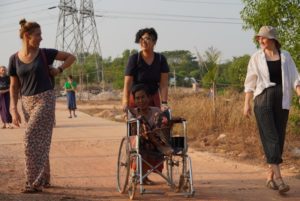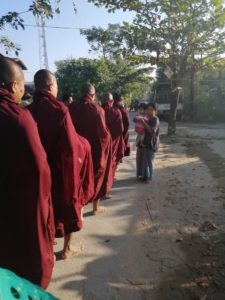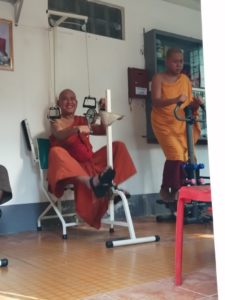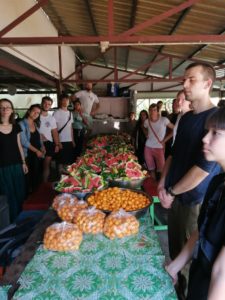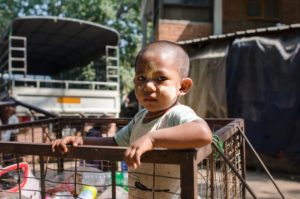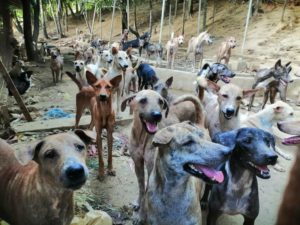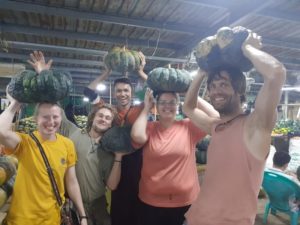Ever thought about volunteering in a monastery? Then this experience could be the one for you.
The Thabarwa monastery just outside Yangon is a refuge, where volunteers from all over the world help poor, handicapped and sick people.
Thabarwa is run exclusively on donations and takes care of over 4000 people. The monastery put special emphasis on empowerment, illustrated perfectly in the rainbow hospital which is located within the complex where patients are given responsibility to help even though they may be able to use their body fully.
One of the patients remarked
Having one arm at least gives me the chance to mop the floor of the ward once a day
What is Tharbarwa?
The monastery is primarily a place where sick or poor people, who do not have the means to look after themselves come for support and to live.
There are also 500 monks that live at Thabarwa. Their daily lives consist of learning and meditation. The resident Buddhist university that is situated within the confines of the complex host regular study sessions. Buddhism teaches that without a peaceful mind you can’t be useful for anyone, so meditation plays an important role in the monastery and is encouraged for volunteers to participate as well.
A Normal Day in the Life of a Volunteer?
This is completely up to you, no activity is compulsory but volunteers normally do two activities daily. One in the morning and one in the afternoon.
There is a strong emphasis on meditation at the centre, but the sessions are not mandatory. Most volunteers wake up at 8.00 am, with most activities starting at 9.00 am. Lunch is served from donations from the local community at 11.30 a.m. After the afternoon activities, 4 or 5 volunteers will cook dinner for everyone. This is paid for by the volunteers who all donate money into a kitty the night before.
Alcohol or drugs are strictly prohibited, so if you do want a beer, people venture out to the local restaurant. (the junction) A no thrills establishment, that is a welcome change from the intensity of Thabarwa. Most volunteers will be asleep by 11 pm.
What are the activities?
Activities aren’t compulsory, but volunteers normally do two each day.
Patient Washing
Volunteering in a monastery can be a joyous experience and certainly this activity is! Jam packed full of music, laughter and bubbles, as you lather up the patients. After taking the patient from their beds to the washing area, you undress them and lather them up. Put the music on full blast and let the water fight commence!
Here is a clip from the activity.
Alms
An incredible insight into a monk’s life, specifically on what they do to make sure they have enough food for the day. Before the sun has risen, monks make their way out into the local communities and with their buckets they beg for food from the people. The reverence local people place on monks is astounding. They don’t have much, but they give what they can give. For more info on the alms, we spoke to a monk at the monastery in an this interview
Physiotherapy
There are more experienced volunteers onsite who train the less experienced volunteers on the best physiotherapist practice. This activity is hugely important for patients as they benefit from increased flexibility and strength. After three months of physio often patients are able to walk, having previously been completely bedridden.
Meditation
When volunteering in a monastery it was suggested to do your upmost to foster a calm mind, free from attachment and craving is the main focus on the meditation. Having the ability to relax your mind puts you in a far better position to be help people. For more information on this, check out our article on a seven day meditation course (also organised of the Thabarwa organisation)
The Past, Present and Future
Established 10 years ago in the setting of a swamp like waste land, where there were only just a few shacks. Slowly as more desperate people started to come, the place was at breaking point.
One man remembered ”fights would often break out over a bowl of rice which were impossible to control”
Authorities would often demand that the centre get shut down, as they claimed it was a breeding ground for undesirable people. The head monk would say ”what do you want me to do with a 1000 thousand people”, the phone calls would stop, then after another phone call 6 months, the head monk would say ”what do you want me to do with 2000 thousand people. Eventually the phone calls stopped and the authorities gave up in their efforts to close the centre down.
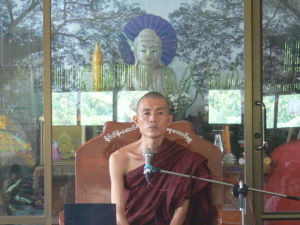
The founder Sayadaw U Ottamasara says you should look after yourself first through meditation before helping other people
As donations started to come in more houses were built. Today there is enough room for thousands of people staying there. The organisation continues to grow as more centres open. The head monk also made a point of more funds will be directed into the western more developed world. In his eyes westerners are sicker compared with Burmese people, even though they have more material wealth yet suffer more through increased attachment and craving.
What are the other Volunteers like?
As you can imagine when you’re volunteering at a monastery it’s not your typical 9 to 5 office worker who comes. Combining this with it being in Myanmar, then you really are going to find some out there people!
The most striking characteristic was how unbelievably caring the people were. Whether or not they had special skills or training, people were willing to get stuck in and help where ever possible.
Volunteers come from all over the world with common countries being Israel, Poland and France. The atmosphere is very relaxed and people don’t put pressure on you to do activities. They just say ”it’s you who needs to look at yourself in the mirror in the evening”, I guess referring to the fact of no one can judge you but yourself.
How does the Centre Function
With so many people staying in the centre, it is a complex operation to make sure everything runs smoothly. The functions exclusively from the good deeds of others. There are very few, if any people who get paid. Making sure everyone is fed is extremely important, so monks go out to beg for donations in the morning. Outside funding makes up a huge proportion of the resources, this help is especially important considering that the local government don’t help at all.
An example of people doing good deeds.
Volunteering at a Monastery? Is it worth it?
You learn not only about the world around you, but also a crazy amount about yourself. You will constantly be putting yourself in situations outside of your comfort zone, and perhaps you will learn skills that you didn’t realise you had. For this reason volunteers often return to the monastery that has impacted them so profoundly.
Here are some picture from the experience.
For more information please have a look at their website.

